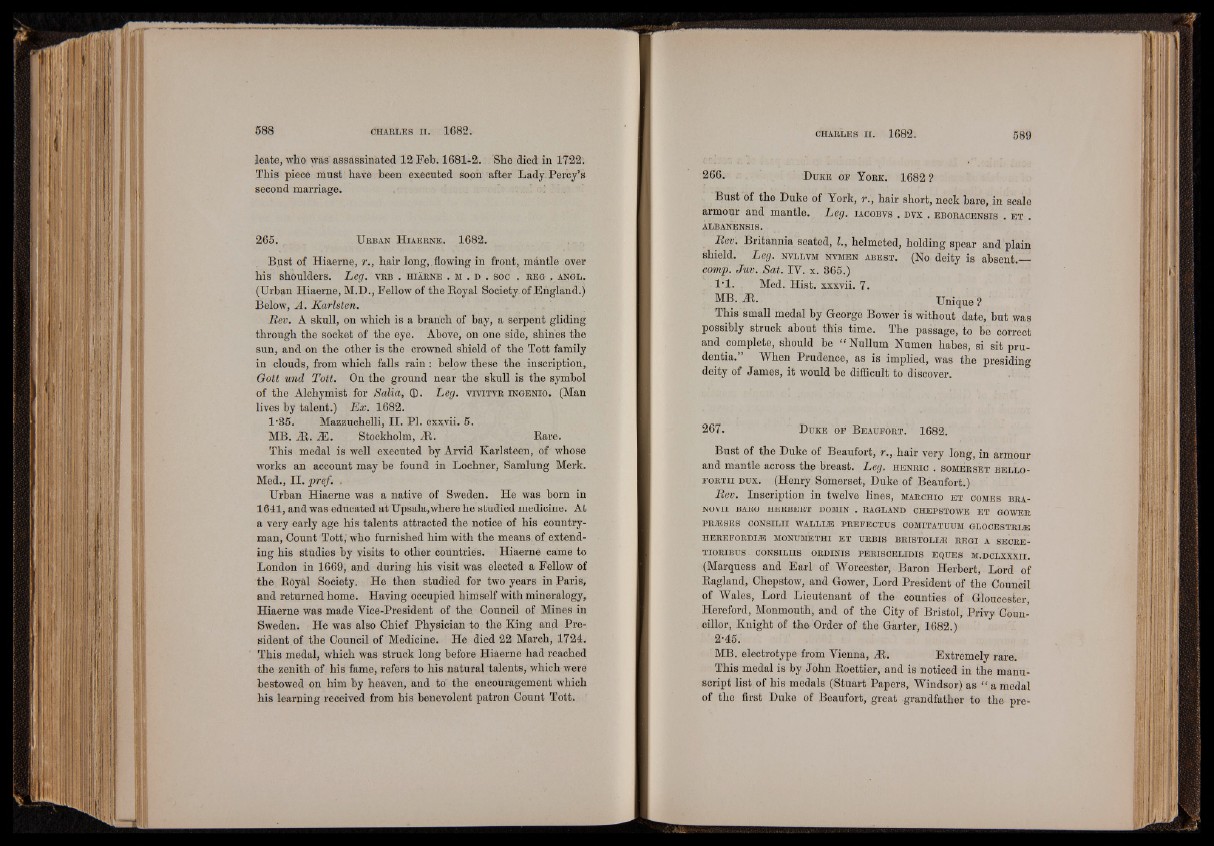
leate, who was assassinated 12 Feb. 1681-2. She died in 1722.
This piece must have been executed soon after Lady Percy’s
second marriage.
265. U r ban H ia e r n e . 1682.
Bust of Hiaerne, r., hair long, flowing in front, mantle over
his shoulders. Leg. vr b . h ia r n e . m . d . soo . r e g . a n g l .
(Urban Hiaerne, M.D., Fellow of the Boyal Society of England.)
Below, A. Karlsten.
Rev. A skull, on which is a branch of bay, a serpent gliding
through the socket of the eye. Above, on one side, shines the
sun, and on the other is the crowned shield of the Tott family
in clouds, from which falls ra in : below these the inscription,
Gott und Tott. On the ground near the skull is the symbol
of the Alchymist for Salia, ®. Leg. v iv it v r in g e n io . (Man
lives by talent.) E x . 1682.
l -35. Mazzuchelli, II. PI. cxxvii. 5.
MB. At. M . Stockholm, At. Bare.
This medal is well executed by Arvid Karlsteen, of whose
works an account may be found in Lochner, Samlung Merk.
Med., II. pref. .
Urban Hiaerne was a native of Sweden. He was born in
1611, and was educated at Upsala,where he studied medicine. At
a very early age his talents attracted the notice of his countryman,
Count Tott,' who furnished him with the means of extending
his studies by visits to other countries. Hiaerne came to
London in 1669, and during his visit was elected a Fellow of
the Boyal Society. He then studied for two years in Paris,
and returned home. Having occupied himself with mineralogy,
Hiaerne was made Yice-President of the Council of Mines in
Sweden. He was also Chief Physician to the King and President
of the Council of Medicine. He died 22 March, 1724.
This medal, which was struck long before Hiaerne had reached
the zenith of his fame, refers to his natural talents, which were
bestowed on him by heaven, and to the encouragement which
his learning received from his benevolent patron Count Tott.
Bust of the Duke of York, r., hair short, neck bare, in scale
armour and mantle. Leg. lacobvs . dvx . e b o r a c e n s is . e t .
ALBANENSIS.
Rev. Britannia seated, I., helmeted, holding spear and plain
shield. Leg. nvllvm n vm en a b e s t . (N o deity is absent.__
comp. Juv. Sat. TV. x. 365.)
1*1. Med. Hist, xxxvii. 7.
MB. At. Unique ?
This small medal by George Bower is without date, but was
possibly struck about this time. The passage, to be correct
and complete, should be “ Nullum Numen babes, si sit pru-
dentia. \Vhen Prudence, as is implied, was the presiding
deity of James, it would be difficult to discover.
267. D u k e o f B e a u fo r t . 1682.
Bust of the Duke of Beaufort, r., hair very long, in armour
and mantle across the breast. Leg. h e n r ic . so m e r s e t b e l l o -
f o r t i i DUX. (Henry Somerset, Duke of Beaufort.)
Rev. Inscription in twelve lines, m ar c h io e t come s b r a -
NOVII BARO HERBERT DOMIN . RAGLAND CHEPSTOWE ET GOWER
PRESSES CONSILII WALLI7E PREFECTUS COMITATUUM GLOCESTRLE
HEREFORDLZE MONUMETHI ET URBIS BRISTOLLE REGI A SECRE-
TIORIBUS - CONSILIIS ORDINIS PERISCELIDIS EQUES M.DCLXXXII.
(Marquess and Earl of Worcester, Baron Herbert, Lord of
Bagland, Chepstow, and Gower, Lord President of the Council
of Wales, Lord Lieutenant of the counties of Gloucester,
Hereford, Monmouth, and of the City of Bristol, Privy Councillor,
Knight of the Order of the Garter, 1682.)
2-45.
MB. electrotype from Vienna, At. Extremely rare.
This medal is by John Boettier, and is noticed in the manuscript
list of his medals (Stuart Papers, Windsor) as “ a medal
of the first Duke of Beaufort, great grandfather to the pre